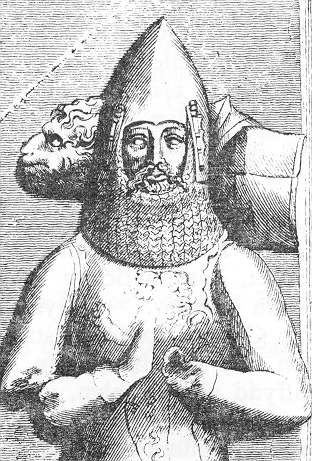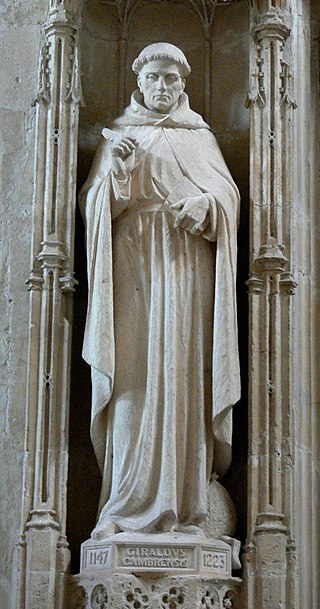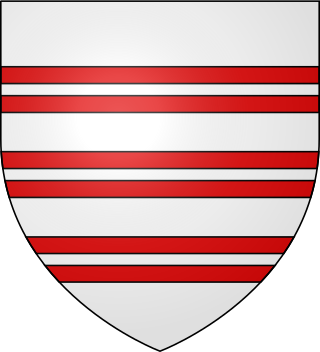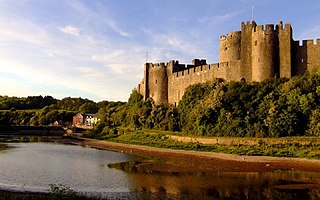
Rhys ap Gruffydd, commonly known as The Lord Rhys, in Welsh Yr Arglwydd Rhys was the ruler of the Welsh kingdom of Deheubarth in south Wales from 1155 to 1197 and native Prince of Wales.

Gerald of Wales was a Cambro-Norman priest and historian. As a royal clerk to the king and two archbishops, he travelled widely and wrote extensively. He studied and taught in France and visited Rome several times, meeting the Pope. He was nominated for several bishoprics but turned them down in the hope of becoming Bishop of St Davids, but was unsuccessful despite considerable support. His final post was as Archdeacon of Brecon, from which he retired to academic study for the remainder of his life. Much of his writing survives.
Diarmait Mac Murchada, was King of Leinster in Ireland from 1127 to 1171. In 1167, he was deposed by the High King of Ireland, Ruaidrí Ua Conchobair. To recover his kingdom, Mac Murchada solicited help from King Henry II of England. His issue unresolved, he gained the military support of the Richard de Clare, 2nd Earl of Pembroke, thus initiating the Anglo-Norman invasion of Ireland.

Robert FitzStephen was a Cambro-Norman soldier, one of the leaders of the Norman invasion of Ireland, for which he was granted extensive lands in Ireland. He was a son of the famous Nest, daughter of Rhys ap Tewdwr, the last king of Deheubarth. His father was Nest's second husband, Stephen, Constable of Cardigan. Following the death of her first husband, Gerald de Windsor, her sons had married her to Stephen, her husband's constable for Cardigan. By Stephen, she had another son, possibly two; the eldest was Robert, and the younger may have been Hywel.

RaymondFitz William Fitz Gerald, nicknamed Le Gros, was a Cambro-Norman commander during the Norman invasion of Ireland. Raymond was among the first of a small band of Norman knights who landed on the South coast of Ireland before being reinforced by a larger force led by Richard de Clare, 2nd Earl of Pembroke. He was active consolidating Norman rule over Ireland before he retired to his estates in Waterford where he died in the late 12th century.
Tighearnán Mór Ua Ruairc, anglicised as Tiernan O'Rourke ruled the kingdom of Breifne as the 19th king in its Ua Ruairc dynasty, a branch of the Uí Briúin. He was a descendant of Uí Riagain, and one of the provincial kings in Ireland in the twelfth century, constantly expanding his kingdom through shifting alliances, of which the most long-standing was with Toirdelbach Ua Conchobair King of Connacht and High King of Ireland, and subsequently his son and successor Ruaidhrí Ua Conchobair. He is known for his role in the expulsion of Diarmait Mac Murchada, King of Leinster, from Ireland in 1166. Mac Murchada's subsequent recruitment of Marcher Lords to assist him in the recovery of his Kingdom of Leinster ultimately led to the Norman invasion of Ireland.
Mac Carthaigh’s Book is a collection of annals of the period AD 1114–1437 inclusive. It was compiled from earlier material by Fínghin Mac Carthaigh Mór an Irish nobleman who was imprisoned for years in London. He was a patron of learning and a scholar in his own right. While in London in 1633 he employed Diarmaid Ó Súilleabháin who also kept the book in his castle until it was sacked by Radhulbh MacAmlaoibh, then his clan took control of it, they copied and compiled these annals for him.

The de Barry family is a noble family of Cambro-Norman origins which held extensive land holdings in Wales and Ireland. The founder of the family was a Norman Knight, Odo, who assisted in the Norman Conquest of England during the 11th century. As a reward for his military services, Odo was granted estates in Pembrokeshire and around Barry, Wales, including Barry Island just off the coast.

Gerald de Windsor, aliasGerald FitzWalter, was an Anglo-Norman lord who was the first Castellan of Pembroke Castle in Pembrokeshire. Son of the first Constable of Windsor Castle, and married to a Welsh Princess, he was in charge of the Norman forces in south-west Wales. He was also steward and governor for the Norman magnate Arnulf de Montgomery. His descendants were the FitzGerald dynasty, as well as the FitzMaurice, De Barry, and Keating dynasties of Ireland, who were elevated to the Peerage of Ireland in the 14th century. He was also the ancestor of the prominent Carew family, of Moulsford in Berkshire, the owners of Carew Castle in Pembrokeshire and of Mohuns Ottery in Devon.
The Synod of Cashel of 1172, also known as the Second Synod of Cashel, was assembled at Cashel at the request of Henry II of England shortly after his arrival in Ireland in October 1171. The Synod sought to regulate some affairs of the Church in Ireland and to condemn some abuses, bringing the Church more into alignment with the Roman Rite. As such it can be seen as a continuation and part of the Irish church reform of the Twelfth Century, with the first synod of Cashel, the Synod of Rathbreasail and the Synod of Kells, slowly embracing the Gregorian Reforms. The extent to which the Synod set the direction for the relationship between the English and the Irish Church has been the subject of scholarly debate. Stephen J. McCormick described the Synod as one of the most important events of this period of Irish history.
Maurice de Prendergast was a Norman knight, fl. 1169–1174.

Gerald FitzMaurice, jure uxoris 1st Lord of Offaly was a Cambro-Norman nobleman who took part with his father, Maurice FitzGerald, Lord of Llanstephan, in the Norman Invasion of Ireland (1169–71). Together with his five brothers and one sister Nesta they founded the notable FitzGerald/FitzMaurice dynasty which was to play an important role in Irish history.

Topographia Hibernica, also known as Topographia Hiberniae, is an account of the landscape and people of Ireland written by Gerald of Wales around 1188, soon after the Norman invasion of Ireland. It was the longest and most influential work on Ireland circulating in the Middle Ages, and its direct influence endured into the early modern period.
Barrymore is a barony in County Cork in Ireland. It is the namesake of the Norman de Barry family, latterly created Earls of Barrymore. Barrymore is bordered by eight baronies:

The siege of Wexford took place in early May 1169 and was the first major clash of the Norman invasion of Ireland. The town was besieged by a combined force of Normans under Robert Fitz-Stephen and soldiers loyal to Diarmait mac Murchadha. After being ousted as King of Leinster, Diarmait had recruited the Normans to help him regain control of Leinster and the semi-independent Norse-Gaelic seaport of Wexford. Although the attackers did not breach the town's walls, Wexford surrendered after almost two days and came under Norman control.
Robert de Barry was a Cambro-Norman warrior from Manorbier in Pembrokeshire who participated in the colonisation of the Kingdom of Desmond following the Norman invasion of Ireland.
Muskerry West is one of the baronies of Ireland, a historical geographical unit of land. Its chief town is Macroom. It is one of 24 baronies in the county of Cork. It may also be viewed as a half barony because sometime before the 1821 census, it was divided from its other half – Muskerry East. Other neighbouring baronies include Duhallow to the north and the Barony of Carbery East to the south.
Imokilly is one of the baronies of Ireland, an historical geographical unit of land. Its chief town is Youghal. It is one of 24 baronies in the county of Cork. Other neighbouring baronies include Barrymore to the west and Kinnatalloon to the north.
Milo de Cogan was an Anglo-Norman knight from Glamorgan who played a significant role in the Norman conquest of Ireland under Richard de Clare, 2nd Earl of Pembroke; a man better known to Irish history as Strongbow.

John Baptist Sleyne was Roman Catholic Bishop of Cork and Cloyne and Apostolic Administrator of the diocese of Ross, who was an enthusiastic patron of the Gaelic language and culture, and an advocate of the severely repressed Roman Catholic population, in Ireland during the early period of the Penal Laws. He was one of only two bishops to minister in Ireland at the end of the 17th century. Sleyne was very learned in languages and moral theology, and had traveled widely. He was known to and had interactions with kings, queens, popes and wider cultural and religious establishment throughout Ireland and Europe. Because Sleyne "remain[ed] in the kingdom contrary to the [penal] law", of the time, he went into hiding. He was eventually brought before the courts in 1698 and spent five years in prison in Cork Gaol. During his time as Bishop, both as fugitive and prisoner, Sleyne ordained many priests and consecrated several bishops in Ireland. He was eventually exiled to Portugal, on 11 February 1703, where he was given shelter in the Irish Dominican Convento do Bom Sucesso, Lisbon. He died in Portugal on 16 February 1712, aged 74 years and is buried at the altar of the Sacred Heart in the Church of Nossa Senhora do Bom Sucesso.










